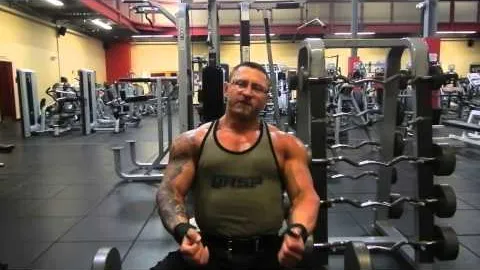
Are you looking to enhance your arm muscles and boost your overall strength? Look no further than the seated to standing barbell curl exercise! This versatile exercise targets your biceps and forearms, helping you build definition and increase your arm size. In this comprehensive guide, we will break down the seated to standing barbell curl exercise, discussing its benefits, proper form, variations, and tips for maximizing your workout. Let's dive in!
The seated to standing barbell curl is a compound exercise that engages multiple muscles in your upper arms. Here are some key benefits of incorporating this exercise into your fitness routine:
Targeted Muscle Development: The primary target muscles of the seated to standing barbell curl are the biceps brachii, brachialis, and brachioradialis. By performing this exercise, you can effectively strengthen and sculpt these muscles, leading to improved arm aesthetics.
Functional Strength: This exercise mimics real-life movements, such as lifting objects or daily activities involving the arms. By reinforcing these movements, you can enhance your functional strength, making everyday tasks easier.
Grip Strength: Since the seated to standing barbell curl involves holding onto a barbell, it can significantly enhance your grip strength. Improved grip strength can benefit various other exercises and activities in your fitness routine.
Flexibility and Stability: This exercise challenges your lower body stability while performing curls in a seated position. The transition from seated to standing adds an element of balance and coordination, improving overall flexibility and stability.
To maximize the benefits of the seated to standing barbell curl and prevent injuries, it's crucial to maintain proper form. Follow these steps to perform this exercise correctly:
Starting Position: Begin by sitting on a flat bench with your feet planted firmly on the ground shoulder-width apart. Hold a barbell in an underhand grip with your hands shoulder-width apart and arms fully extended.
Seated Curl: Keep your upper arms stationary, engage your biceps, and slowly curl the barbell towards your shoulders. Ensure that your elbows remain close to your torso throughout the movement. Exhale during this phase.
Transition: Once you've completed the seated curls, push off the bench with your legs and transition into a standing position while maintaining control over the barbell. Keep your core engaged to stabilize your body during the transition.
Standing Curl: In the standing position, continue curling the barbell towards your shoulders using controlled movements. Focus on squeezing the biceps at the top of the movement. Inhale during this phase.
Reverse the Movement: Gradually lower the barbell back to the starting position in a controlled manner while maintaining proper form. Avoid swinging or using momentum to lift the weights.
As you build strength and become more comfortable with the seated to standing barbell curl, you can incorporate variations to challenge your muscles further. Here are some effective variations:
Wide-Grip Seated to Standing Barbell Curl: Place your hands on the barbell with a wider than shoulder-width grip. This variation targets the outer biceps and forearms, adding variety to your workout routine.
Narrow-Grip Seated to Standing Barbell Curl: Position your hands close together, keeping them a few inches apart. This variation emphasizes the inner biceps, helping you develop a well-rounded arm physique.
Alternating Seated to Standing Dumbbell Curl: Switch the barbell for a pair of dumbbells. This variation allows for unilateral training, helping to correct muscle imbalances and improve overall arm symmetry.
Eccentric Seated to Standing Barbell Curl: Focus on the eccentric (lowering) phase of the movement by gradually lowering the barbell in a slow and controlled manner. This variation increases time under tension and places more stress on the muscles, leading to greater muscle development.
To ensure an effective and safe workout, keep the following tips in mind:
Warm-Up: Always warm up your arms with some light cardiovascular exercises and dynamic stretches before starting any bicep workout.
Controlled Movements: Focus on slow and controlled movements throughout the exercise. Avoid using momentum or swinging the barbell, as this can lead to diminished results and potential injury.
Proper Breathing: Exhale during the exertion phase (curling the barbell towards your shoulders) and inhale during the lowering phase. This breathing technique helps maintain proper form and ensures you receive enough oxygen during the exercise.
Progressive Overload: Gradually increase the weight or reps as your strength improves. Progressive overload is essential for continued muscle growth and strength development.
Rest and Recovery: Allow your muscles to rest and recover adequately between workouts. Aim for at least 48 hours of rest before targeting the same muscle group again.
The seated to standing barbell curl exercise is a fantastic addition to any arm training routine. By emphasizing proper form, incorporating variations, and following our tips, you can optimize your workout and achieve great results. Remember to start with lighter weights and gradually increase the intensity as your muscles adapt. Stay consistent, be patient, and enjoy the journey towards stronger and more defined arms! Happy lifting!
If you're looking for a gym, fitness club or yoga studio, you've come to the right place.
You can find information about gyms in your area. Browse catalog of gyms and find gyms with classes which are you looking for.
On gym page you can find simple information like address, phone or website. You can find list of available classes. You can check availability of personal training or small group classes. On place page you can also see information about open hours.
You can find gyms near you with amenities, courts, studios and equipments.
Use our map to find gym at your city or district.
In Gym Navigator you can find list of exercises with movies for many body parts.
You can browse exercises catalog and find exercises the best of you.
You can also find exercises grouped into workout plans, which you can use to improve you body. Each routine show you exercises one by one and give you possibility to count you progress and count down rest time.